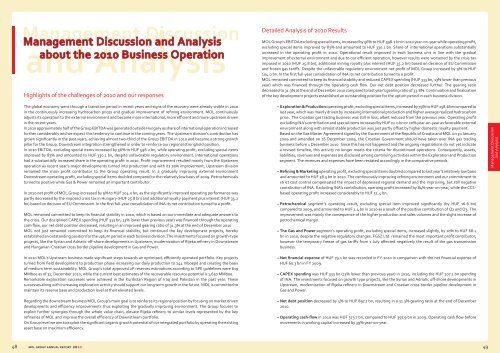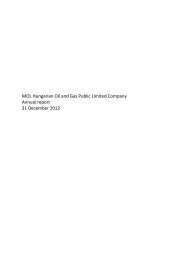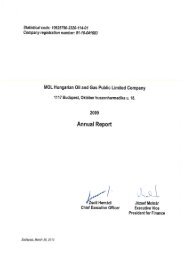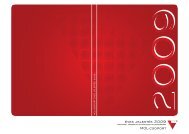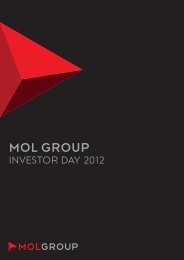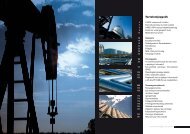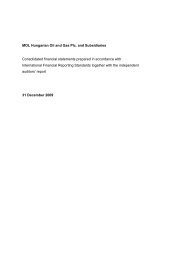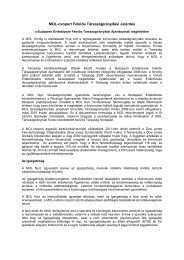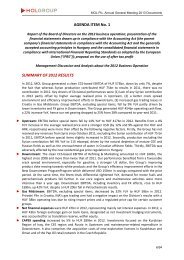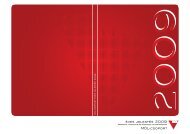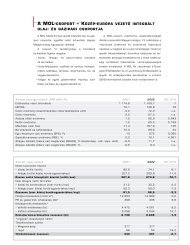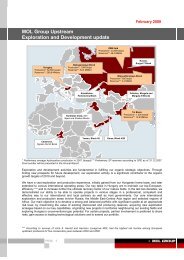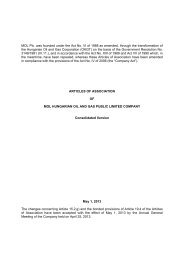MOL GROUP Annual Report
MOL GROUP Annual Report
MOL GROUP Annual Report
- No tags were found...
Create successful ePaper yourself
Turn your PDF publications into a flip-book with our unique Google optimized e-Paper software.
Management Discussion and Analysisabout the 2010 Business OperationHighlights of the challenges of 2010 and our responsesDetailed Analysis of 2010 Results<strong>MOL</strong> Group’s EBITDA excluding special items, increased by 56% to HUF 598.2 bn in 2010 year-on-year while operating profit,excluding special items improved by 83% and amounted to HUF 330.1 bn. Share of international operations substantiallyincreased in the operating profit in 2010. Operational result improved in each business unit in line with the gradualimprovement of external environment and due to our efficient operation, however results were worsened by the crisis taximposed in 2010 (HUF 25.8 bn), additional mining royalty plus interest (HUF 35.2 bn) based on decision of EU Commissionand frozen gas tariffs. Despite the unfavorable regulatory environment net profit of <strong>MOL</strong> Group increased by 9% to HUF104.0 bn. In the first full-year consolidation of INA its net contribution turned to a profit.<strong>MOL</strong> remained committed to keep its financial stability and reduced CAPEX spending (HUF 333 bn, 13% lower than previousyear) which was financed through the operating cash flow. Our net debt position decreased further. The gearing ratiodecreased to 31.3% at the end of December 2010 compared to last year’s gearing ratio of 33.8%. Continuation and finalizationof the key development projects established an outstanding position for the upturn period in each business division.The global economy went through a transition period in recent years and signs of the recovery were already visible in 2010in the continuously increasing hydrocarbon prices and gradual improvement of refining environment. <strong>MOL</strong> continuouslyadjusts its operation to the external environment and became more international, more efficient and more upstream drivenin the recent years.In 2010 approximately half of the Group EBITDA was generated outside Hungary as share of international operation increasedfurther considerably and we expect this tendency to continue in the coming years. The Upstream division’s contribution hasgrown significantly in the past years, achieving almost two-third of the Group EBITDA in 2010 and became a strong growthpillar for the Group. Downstream integration strengthened in order to reinforce our regional stronghold position.In 2010 EBITDA, excluding special items increased by 56% to HUF 598.2 bn, while operating profit, excluding special itemsimproved by 83% and amounted to HUF 330.1 bn, despite unfavorable regulatory environment. International operationshad a substantially increased share in the operating profit in 2010. Profit improvement resulted mainly from the Upstreamoperation as recent year’s major developments turned into production and with its 79% improvement, Upstream divisionremained the main profit contributor to the Group operating result. In a gradually improving external environmentDownstream operating profit, excluding special items doubled compared to the relatively low basis of 2009. Petrochemicalsturned to positive while Gas & Power remained an important contributor.In 2010 net profit of <strong>MOL</strong> Group increased by 9% to HUF 104.0 bn, as the significantly improved operating performance waspartly decreased by the imposed crisis tax in Hungary (HUF 25.8 bn) and additional royalty payment plus interest (HUF 35.2bn) based on decision of EU Commission. In the first full-year consolidation of INA its net contribution turned to a profit.<strong>MOL</strong> remained committed to keep its financial stability in 2010, which is based on our immediate and adequate answers tothe crisis. Our disciplined CAPEX spending (HUF 333 bn, 13% lower than previous year) was financed through the operatingcash flow, our net debt position decreased, resulting in an improved gearing ratio of 31.3% at the end of December 2010.<strong>MOL</strong> not just remained committed to keep its financial stability, but continued the key development projects, herebyestablished an outstanding position for the upturn period in each business division. The investments focused on growth-typeprojects, like the Syrian and Adriatic off-shore developments in Upstream, modernization of Rijeka refinery in Downstreamand Hungarian-Croatian cross border pipeline development in Gas and Power.– Exploration & Production operating profit, excluding special items, increased by 79% to HUF 258.6 bn compared tolast year, which was mainly driven by increasing international production and higher average realized hydrocarbonprice. The Croatian gas trading business was still in loss, albeit reduced from the previous year. Operating profitexcluding INA’s contribution and special items increased by HUF 22.0 bn or 20% year-on-year as favorable externalenvironment along with almost stable production was just partly offset by higher domestic royalty payment.Based on the Gas Master Agreement signed by the Government of the Republic of Croatia and <strong>MOL</strong> on 30 January2009 and amended on 16 December 2009, the Croatian Government should have taken over INA gas tradingbusiness before 1 December 2010. Since this has not happened and the ongoing negotiations do not yet indicatea revised timeline, this activity no longer meets the criteria for discontinued operations. Consequently, assets,liabilities, revenues and expenses are disclosed among continuing activities within the Exploration and Productionsegment. The revenues and expenses have been restated accordingly in the comparative periods.– Refining & Marketing operating profit, excluding special items doubled compared to last year’s relatively low basisand amounted to HUF 58.5 bn in 2010. The continuously improving refining environment and our commitment tostrict cost control compensated the impact of depressed regional demand and the improving, but still negativecontribution of INA. Excluding INA’s contribution, operaing profit increased by 84% year-on-year, while the CCSbasedoperating profit increased considerably to HUF 51.4 bn.– Petrochemical segment’s operating result, excluding special item improved significantly (by HUF 16.6 bn)compared to 2009, and amounted to HUF 1.4 bn in 2010 as a result of the positive contribution of Q2 and Q3. Theimprovement was mainly the consequence of the higher production and sales volumes and the slight increase ofpetrochemical margin.– The Gas and Power segment’s operating profit, excluding special items, increased slightly, by 10% to HUF 68.1bn in 2010, despite the negative regulatory changes. FGSZ Ltd. remained the most important profit contributor;however the temporary freeze of gas tariffs from 1 July affected negatively the result of the gas transmissionbusiness.Management Discussionand AnalysisIn 2010 <strong>MOL</strong>’s Upstream business made significant steps towards an optimized, efficiently operated portfolio. Key projectsturned from field development to production phase increasing our daily production to 144 mboepd and creating the basisof medium term sustainability. <strong>MOL</strong> Group’s total approved 2P reserves estimations according to SPE guidelines were 619MMboe as of 31, December 2010, while the current best estimates of the recoverable resource potential is 1,650 MMboe.Remarkable exploration successes were achieved in the Kurdistan Region of Iraq and Pakistan in the past year. Thesesuccesses along with increasing exploration activity should support our long term growth in the future. <strong>MOL</strong> is committed tomaintain its reserve base and production level at their elevated levels.Regarding the downstream business <strong>MOL</strong> Group’s main goal is to reinforce its regional position by focusing on market drivendevelopments and efficiency improvements thus exploiting the gradually improving environment. The Group focuses toexploit further synergies through the whole value chain, elevate Rijeka refinery to similar levels represented by the keyrefineries of <strong>MOL</strong> and improve the overall efficiency of Downstream portfolio.On Group level we aim to exploit the significant organic growth potential of our integrated portfolio by operating the existingasset base on maximum efficiency.– Net financial expense of HUF 79.1 bn was recorded in FY 2010 in comparison with the net financial expense ofHUF 60.3 bn in FY 2009.– CAPEX spending was HUF 333 bn (13% lower than previous year) in 2010, including the HUF 107.1 bn spendingof INA. The investments focused on growth type projects, like the Syrian and Adriatic off-shore developments inUpstream, modernization of Rijeka refinery in Downstream and Croatian cross border pipeline development inGas and Power.– Net debt position decreased by 4% to HUF 897.7 bn, resulting in a 31.3% gearing ratio at the end of December2010.– Operating cash-flow in 2010 was HUF 373.7 bn, compared to HUF 397.9 bn in 2009. Operating cash flow beforemovements in working capital increased by 39% year-on-year.48 <strong>MOL</strong> Group annual report 2010 49


